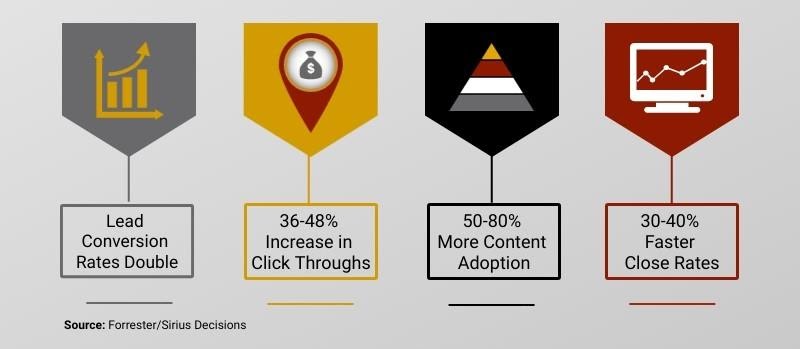Marketing strategies constantly evolve around fresh ideas and new tactics. Done correctly, buyer personas serve as guardrails to keep you from veering off track.
But many marketing teams believe they need a persona for every buying influencer in every company category in their market. That’s a mistake and a costly one at that.
B2B marketers that want to have the right number of personas and, most importantly, useful ones, begin by focusing on the buying decisions they want to influence. Insights into those buying decisions —and then the people who make them— will determine how many buyer personas you need.
Here’s a tip: It’s almost always fewer than you think.
Psychographics Will Lead You Astray
You may have the idea that your persona’s psychographics will reveal insights that will help you market to them. A common practice for consumer marketers, psychographics involve profiling buyers based on their personality, values, and lifestyles. But it’s a waste of time for B2B marketers and can even be dangerous. My friend Rob is a CFO that you might associate with a risk-averse persona, and yet his personal time is devoted to rock climbing cliff walls and navigating the most difficult ski runs.
A statistical analysis might tell you that most CFOs are risk-averse, satisfying your desire to put a label on this persona. But wouldn’t it be more helpful to understand how all CFOs, including those like Rob, make decisions to invest in solutions like yours? If the CFO has to sign off on the SaaS solution you are marketing to the HR buyer, wouldn’t you want to anticipate his questions and prepare the answers your HR persona will need to win him over?
Demographics are Rarely Relevant
Demographics related to the buyer’s company are another source of persona proliferation, as marketers can easily build personas based on attributes such as industry, company size or geographic location. But do these personas help you understand differences in the buying decisions you want to influence?
We’ve interviewed thousands of B2B buyers for hundreds of personas over the last decade, evaluating our clients’ assumptions that demographics matter. Of these attributes, geographic location is typically the least relevant factor. Our increasingly global economy has homogenized the business buyer’s needs and it is increasingly rare to find buyers whose approach to the same buying decision varies by location.
The industry is also another consistently irrelevant factor. Although B2B buyers often prefer providers who are focused on their industry, this is not unique to any particular industry. Your persona merely identifies the need for the buyer to see content specific to their type of company, regardless of what that might be.
The only demographic that we have found to be relevant is company size. A company with 20,000 employees often has very different buying expectations than one with 2,000 or 200. If you are marketing to companies across a wide range of company sizes, you should expect that you will need multiple personas, as the complexity of the buyer’s journey, number of decision makers, and questions they ask will vary widely.
The Most Important Persona Attribute is the Buying Decision
Consider that the marketer’s job is to influence their persona’s decision to buy and it’s easy to see why personas should be defined by differences in the way buyers approach those decisions.
In B2B marketing, there are two buying decisions that typically involve different personas and approaches.
One type of buying decision is made by someone that we’ll label the Economic buyer. The person in this role is making the decision that the status quo needs to change. For a marketer who needs to influence an executive to sponsor this type of investment, this is the buyer who can find the budget, the resources, to make it happen.
The second type of buyer and buying decision is someone we’ll call the Lead Evaluator. This is the buyer who works with all of the other buyer personas in the buying committee to research and agree on the provider they prefer. The Lead Evaluator is most likely to be on your website, visiting with your salespeople and listening to presentations, and they’re also taking those same steps with your competitors.
If your marketing job is to encourage more investment in your solution category, the Economic buyer is your primary persona. Lead Evaluators are the most important persona when your primary goal is to get your company into the buyer’s consideration set and help your salespeople win that business.
Interview Recent Evaluators to Learn About Buying Decisions
The most valuable method of learning about differences in your buyer personas’ decision is through direct conversations with recent evaluators for solutions like yours. Their buying experiences are the only way to gain deep insight into the motivations, concerns, and objections that factor into their investment in a solution like yours.
You might decide to interview both the Economic buyer and the Lead Evaluator, but if you have limited time, the Lead Evaluator’s role in the buying committee provides the most insight. During these interviews, you can ask about the other decision makers and their concerns. You may learn that certain members of the buying committee require separate interviews, but you could just as easily learn that many of the personas you were imagining were passive observers.
You will also learn that buyers across the buying committee have concerns you didn’t anticipate. For example, you may find that an IT buyer is concerned with the way the solution will improve customer satisfaction, and someone in a customer service role might surprise you by talking about the need for an integrated solution.
A buyer persona is a powerful tool that helps marketers make decisions about how to go to market. The right number of buyer personas for your company will only emerge when you have insights into how buyers approach the buying decision you want to influence. These insights will tell you which personas you most need to engage, plus what you need to do and say to earn their business. Whether you end up with one, two, or many more personas, keep your focus on the goal to gain real insight into how buyers evaluate their options and make a decision.





